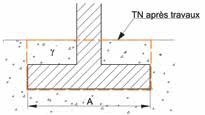Once the constraint qnet calculated, it is possible to carry out checks of bearing capacity of the ground.
It is necessary to check for all cases of charges and combinations of actions, the following inequality:
![]()
With:
Vd: calculation value of the vertical load transmitted by the foundation without taking into account the thrust of Archimedes(36);
Rv;d: calculation value of the ultimate resistance of the ground;
R0: value of the weight of the volume of soil consisting of the volume of the foundation located below the level of the ground after work and the soils between this foundation and the level of the ground after work:
![]()
With:
q0: total vertical stress that would be obtained at the end of work at the base of the surface foundation in the absence of it (Figure 10).
|
|
|
TN after horizontal work |
TN after sloped work (safely) |
Case of caissons or hollow basins |
Figure 10: Possible representation of soil volume weight R0
The ultimate resistance of the ground is calculated as follows:
![]()
With
Rv;k: characteristic value of the net resistance of the ground under the surface foundation;
γR;v: partial lift resistance factor specified in Table 19;
γR;d;v: model coefficient associated with the calculation method used, common to the different limit states;
A': effective surface area of the surface foundation given in Table 15 [Annex Q];
ie : coefficient of reduction of the lift linked to the eccentring of the load (cf. paragraph 2.4 of this chapter);
A: surface of the sole.
In conclusion, the following inequality must be verified:
![]()
The model coefficient(37) γR;d;v has a value of 1,2 when using the pressiometric or penetrometriq eu methods [D.1 (2) and E .1 (2)] .
Regarding the method of calculating qnet from the soil shear strength, the values of the methods can be found in Annex F.1 of standard NF P94-261.
The values of the partial factor on resistances for the bearing limit state γR;v are given in Table 19.
|
ELS almost-permanent [13.4 ] |
ELS characteristics [13.4 ] |
ELU sustainable and transitional [9.1 (3)] |
ELU accidental [9.7 ] |
|
2,3 |
2,3 |
1,4 |
1,2 |
Table 19: Value of the partial bearing resistance factor as a function of limit states


